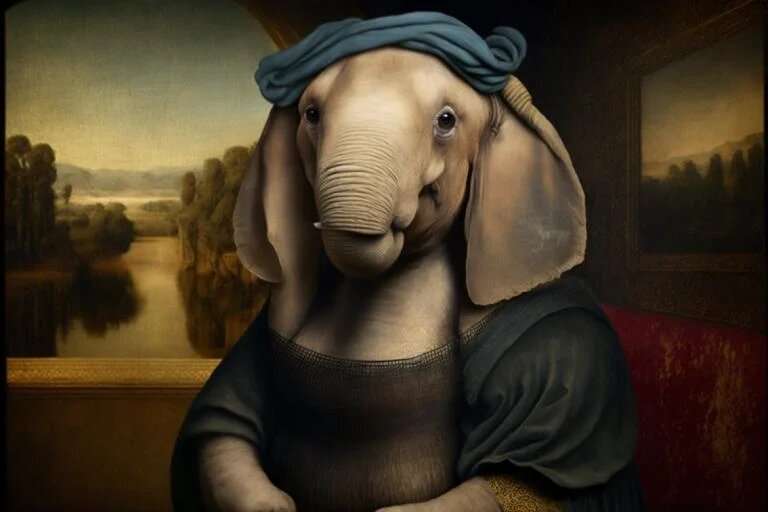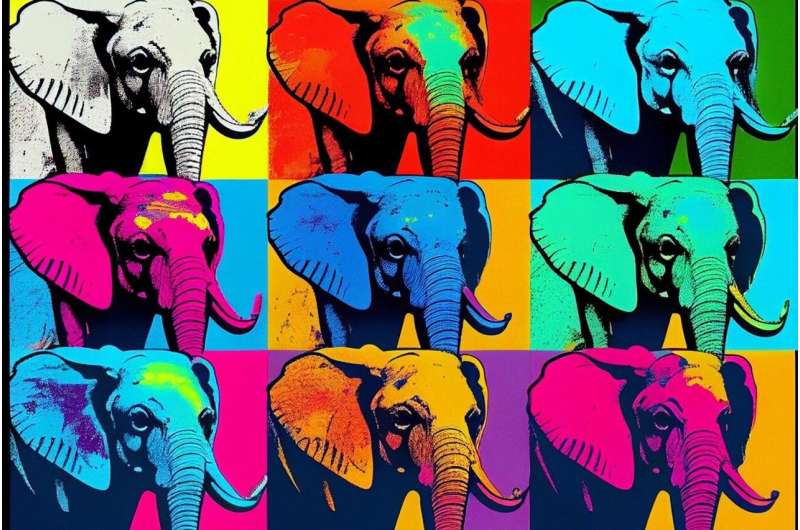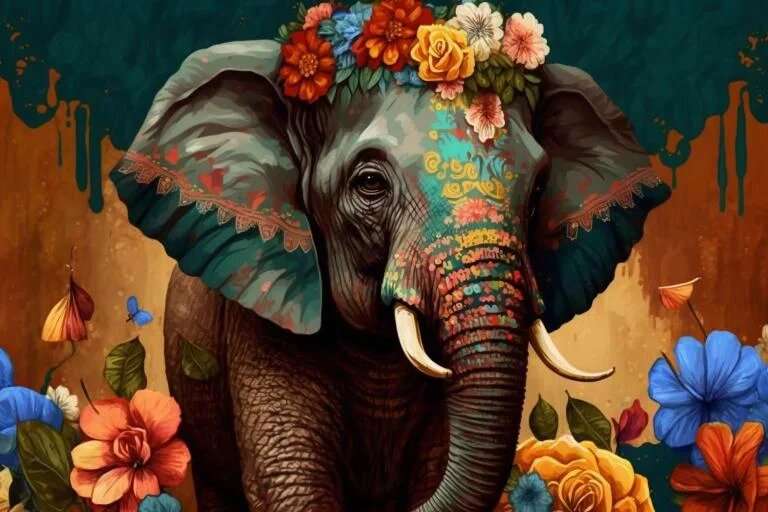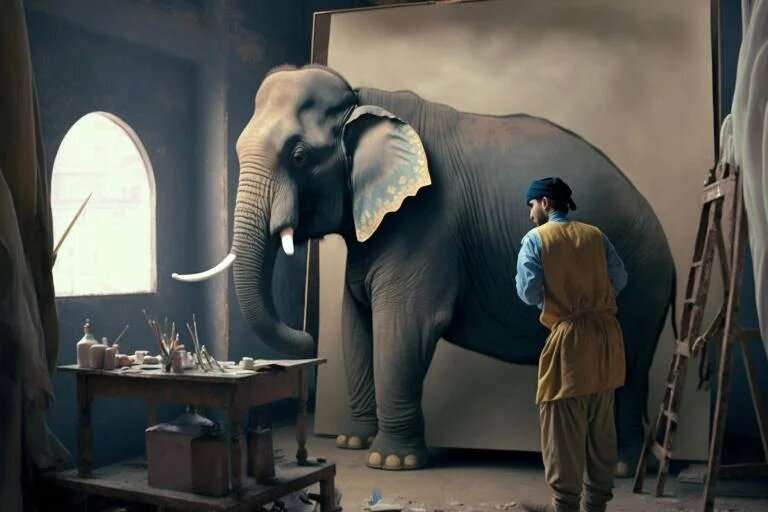This article has been reviewed according to Science X's editorial process and policies. Editors have highlighted the following attributes while ensuring the content's credibility:
fact-checked
trusted source
proofread
Algorithms have put the AI in painting, but is it art?

"In recent years, the emergence of artificial intelligence (AI) has revolutionized various industries, including the world of art. With AI-powered algorithms and machine learning, artists are now exploring new frontiers in the realm of visual art."
That was how ChatGPT, an AI chatbot, suggested we start this story. We asked it for an introduction to an article in which four artists and professors of the practice at SMFA at Tufts sat down to weigh the pros and cons of AI art generators.
The artists' verdict? Contrary to ChatGPT's rosy view, they say it's early to call AI art a revolution, and they question just how meaningful those "new frontiers" will be.
How it works: The algorithms in generators like Dall-E 2, Midjourney, and DreamStudio analyze billions of existing artworks found on the internet and use that information to create original pieces, based on parameters you provide. You can even ask them to copy the style of a particular artist, as in "A portrait of Jumbo the elephant, in the style of Leonardo da Vinci."
To give AI a fighting chance in this roundtable, we spoke to artists with a history of embracing technology. Virtual reality, 3D, and custom software are familiar tools to Cristobal Cea S, Elisa Giardina Papa, and Kurt Ralske, who all teach digital media at SMFA at Tufts, as does Nate Harrison, who has also written extensively about intellectual property and creative processes.
Tufts Now spoke with them about AI's impact on the livelihoods of commercial artists, whether AI art is a continuation of postmodernism, and what outsourcing art to AI means for human creativity.
Tufts Now: Have you seen any AI-generated art that you've found interesting?
Elisa Giardina Papa: Last semester, I taught a class that was called Art/Gender/Technology, and several students used AI tools to generate part of their artwork. Some students tried to embrace AI image generation in terms of creating something from the point of view of fluid subjectivity. It was connected to queer theory and the idea that a subject can mutate and flow and change. They were interested in potential of unfixed subjectivity on the part of the AI. I thought it was a really interesting way to look at it.
Kurt Ralske: Good artists will be able to figure out ways to use these tools to make interesting statements. But that's because they were good artists to begin with.
Cristobal Cea S: I like Elisa's art very much. [Giardina Papa spent months working for an AI company helping it train machines to recognize human emotions; she turned what she learned about the human labor behind AI into an art installation.] I like Ian Cheng's work. [Cheng created an AI-generated creature that changes and grows as viewers interact with it in a gallery.] I also like Juan Covelli, a Colombian artist who has used AI to recreate Mesoamerican artifacts, allowing him, in a sense, to repatriate them to the counties they were taken from.
Those are uses of AI that are witty. And I think wit is a current throughout art history. To do stuff in a way that is unpredictable. AI is good at making predictions, but creativity is very related to finding improbable stuff or improbable outcomes.

Ralske: I'll make a very minor challenge to that. It is possible for these algorithms to generate stuff that you totally didn't expect. Sometimes if you give it a very vague prompt, it will come out with extraordinary things. Because the data set is so large, the possibility of unpredictability is there. You could argue that it's a limited kind of unpredictability, but I definitely have been shocked a few times playing with these tools.
Cea: It has that humorous stuff, right? It's like Google search poetry.
Do you consider AI generators as tools for artists?
Cea: It's a tool you think with and not an end in itself.
Nate Harrison: I think AI is a tool. It's maybe more than that. Maybe it's a tool in the becoming or a meta tool.
Cea: When cinema appeared, the content of cinema was theater. The first films were just basically the theater recorded. In time, the language of cinema appeared. AI's language is yet to arrive, which is exciting.
Harrison: Did a similar thing happen with the invention of photography? The camera was a scientific tool at that point but over time it did acquire its own language.
Giardina Papa: There is a lot of hype for these new tools. But I feel it's marketing rhetoric. I don't see enthusiasm from artists. When the film camera came out—I'm thinking about Walter Benjamin and the optical unconscious or Jean Epstein or Dziga Vertov and the Soviet cinema—they saw this as a tool that could allow us to see things that we didn't see with the naked eye. There was a lot of excitement about the new possibility of vision and of understanding nature and the human in a different way.
Now AI is just reflecting back what we already produce. It's not really giving new vision.
Ralske: I do think this is postmodernism. If you think of art historically, there was a moment, maybe around 1970, where the subjectivity of the artist became less important than the images, text, or meanings that were in circulation in culture, and that the artist's job under postmodernism was to do something interesting with this stuff that already existed.
I would say that artistic approach is maybe made a little bit obsolete by these tools, because this is exactly what the tool is doing. It's learning what images are in existence and regurgitating them and reconfiguring them in an uncritical way. But I think it has an affinity to what postmodern artists did.

What will this mean for the livelihoods of artists?
Ralske: I am quite disturbed that there are many creative people who make their living doing commercial artwork who are going to be out of work. I think this is serious and it's difficult to discuss these tools in an ivory-tower way when that is the reality.
Harrison: Yes, where this is going to be a punch in the gut is in the commercial arena. If you're an illustrator who is not invested in concept and is building a reputation through a very specific style—perhaps you're really good at drawing, for example—that's where there's going to be a huge impact.
Giardina Papa: To me a question of these art generators is where these images are sourced from and the problems of copyright.
Harrison: As far as I understand how it works with the scraping of these data sets, it's not really copying. It's as if you could go to a museum and study every painting in that museum really thoroughly for 40 years. And then you paint a painting based on all that knowledge.
This is all to say that I've read the various lawsuits going on right now. As an artist, I definitely empathize with the plaintiffs, and at the same time, at least under United States law, you can't copyright a style.
It breaks my heart to say this, but if you look at case precedent, it's not on the side of the artist.
What about the artists who say they did not give the AI companies permission to use their works to train the AI programs?
Harrison: This exact same thing happened to Google books a few years ago when Google's algorithms trained its computers to read and scan millions and millions of books without the authors' permission. The courts ruled that that was a fair use, that Google was taking the books and transforming them into an entirely different use as a search tool.
With AI-generated art, you don't see any part of the original images in the new image. It's an amalgam, and it's oftentimes a train wreck, but the AI companies will argue that it's transformative use. The artists will argue that they didn't give their permission to use these materials, but there's long established court precedence that says that doesn't matter. Is it ethically fair? I don't know. The answer to that question gets a little darker.
Cea: It basically industrializes creative labor.
Is that something that's worth fighting against?
Ralske: Where do I sign up to fight?
Giardina Papa: When Nate was talking about style, it made me think, can you just reproduce a style? And decontextualize it from the historical period, the community, the geographical area, the body of the person who did it? Dada came out of the First World War, and there is no way that those images can have the same meaning when they are repurposed in AI one century later.

Harrison: I'm personally not too worried about some AI bot taking my style or Elisa's or Kurt's or Cristobal's. There's just too much involved in the concepts of these works to copy it.
Ralske: That's what's missing from the algorithms. AI is categorizing the qualities and relation of pixels within an image. There is also some kind of semantic tagging going on where images have been tagged by people. What's missing is whatever concept was involved in the creation of the work.
Cea: I tried to have Dall-E make its version of my own work. And it was really hard to describe, and I have to say, I like mine better.
What about the kind of work involved in creating AI images? No drawing, no painting—just typing in some words? Does that decrease its value as art?
Ralske: I like the definition of art that came from the critic Arthur Danto when he was writing about Warhol. He said art is that which is presented as a candidate for consideration as a meaningful work of art. Art doesn't necessarily require an individual sweating in a studio somewhere; the work of art comes into existence only because somebody said, "Hey, I demand that this be considered as a work of art."
Maybe it doesn't matter if this thing was generated by an algorithm if it's placed in a context where we can receive meaning from it. Then it is art. Maybe.
How do you think AI will change art for the future?
Giardina Papa: It seems like we're stuck in this loop in which the only way to imagine the future is to imagine it brought by computers and artificial intelligence. Can we think about the future in a different way?
Cea: I spend a lot of time thinking about what is human. One human thing is desire. I find myself wondering what is AI's desire? We humans make art because we're sad. We make art because we're hangry. We don't make art because we have a ton of art books.
Ralske: One of the best outcomes of the popularization of AI tools is that it forces us to think harder about what it is that we can do that the machines can't do. Maybe this means a return to materiality of objects, or increased interest in virtuosity, or a focus on our creatureliness. Whatever it is we do that is impossible for the machine to reproduce—that becomes where the action is.
I'm reminded of a quote by the free jazz musician and theorist Sun Ra, the father of Afrofuturism. In the 1970s, he had advice for drummers, something to the effect of "the drum machines are coming, so you better start playing some different beats."
Machines can be perfect and predictable. But humans can do what machines can never replicate, which is to do with conviction something that is a manifestation of organic imperfection.
I just hope that one of the side effects of AI is that creative people feel emboldened to become even more creative.



















